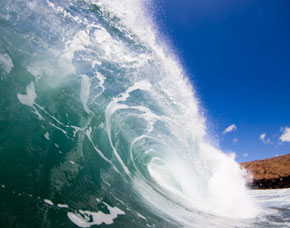About Sea Plants
 Wherever sunlight, warmth and nourishment are found in nature, there life will be found also. This applies to the sea as well as to the land. For several million years, sea plants, more commonly referred to as seaweed, have been the most economical way of exploiting the sunlight, warmth and nourishment found at the edges of oceans.
Wherever sunlight, warmth and nourishment are found in nature, there life will be found also. This applies to the sea as well as to the land. For several million years, sea plants, more commonly referred to as seaweed, have been the most economical way of exploiting the sunlight, warmth and nourishment found at the edges of oceans.
Although there are thousands of different kinds of sea plants they are divided by color into the reds, greens and browns, and within each group there are many varieties.
The most popular in the red group are the Dulse and Irish Moss, while sea lettuce represents the green group, followed by the brown kelps, which are the largest of the algae, some of which attain a growth exceeding 33 meters ( 100 feet )
All three groups are exploited for their use as a human and animal food, fertilizer, and medicine.
Sea plants are not produced from seed, but in common with other non flowering plants, such as mushroom, reproduce themselves by producing spores.
Unlike land plants, sea plants are simple in structure, having no true leaves, stems, or roots, but developes a “holdfast,” which anchors the plant to a rock or any other surface the spore settles.
Not all sea plants have holdfasts, the sea plants of the Sargasso Sea are one example.
Since the sea water is the “soil” for sea plants the growing conditions are much different from those plants on land, in many ways.
The sea is a more consistent environment. There are no rapid changes in temperature, nor are there any arid areas, as there is on land. There is never a shortage of nourishment as there may be in the soil for land plants.
Sea water contains all known chemical elements and these nutrients are being constantly replenished by nature; as the nutrients leached out of fields by rain (which are then lost to agriculture) find their way to the sea, where, in common with all the other salts and minerals there, they are universally and uniformly available.
Thus living in a stable nutrient environment they always maintain a stable hemical composition.
Sea plants like land plants, contain carbohydrates, but differ in many ways. Sea plant carbohydrates decompose more quickly in soil. They promote the enhanced growth of soil bacteria, because they contain a higher percentage of simple sugars which require no further decomposting as bacteria food, and the cellulose content is much lower.
The main carbohydrates in the brown sea plants which are used in agriculture are mannitol, laminarin, fucodin and alginic acid. There are many more components in sea plants such as auxins, giberellins, cytokinin, vitamins, race minerals. Its significance in agriculture and horticulture is being better understood and appreciated by researchers and growers, both commercial and home gardeners, throughout the world.
The unique blend of components contained in sea plants have been extremely beneficial as a food for both humans and animals. An overall improvement in health is generally noted by those who incorporate sea plants into their daily diet. The same effect on livestock has been noted by farmers, and pet owners experience similar results.
